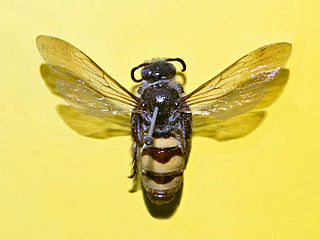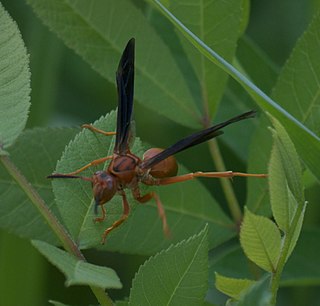Related Research Articles

The Tiphiidae are a family of large, solitary wasps whose larvae are parasitoids of various beetle larvae, especially those in the superfamily Scarabaeoidea. Until recently, this family contained several additional subfamilies, but multiple studies have independently confirmed that these comprise a separate lineage, and are now classified in the family Thynnidae.

Cephoidea is a small superfamily within the Symphyta, commonly referred to as stem sawflies, containing some 100 species in 10 genera in the living family, Cephidae, plus another 17 genera in the extinct family Sepulcidae. Most species occur in the Northern Hemisphere, especially in Eurasia. The larvae are stem borers in various plants, especially grasses, but sometimes other herbaceous plants, shrubs, or trees. A few are pests of cereal grains. They are exceptionally slender for symphytans, often resembling other types of wasps, and they are the only Symphyta which lack cenchri. They are sometimes postulated to be the sister taxon to the Apocrita, though the Orussidae are more commonly considered such.

Chalcoela iphitalis, the sooty-winged chalcoela, is a moth species of the family Crambidae that occurs throughout North America. They are seen as far south as California, Arizona and South Carolina and as far north as Ontario. Adults can be seen from May to August. The head, body and front portion of the forewings are yellow-orange while the hindwing and back portion of the forewings are grey and silver. The back edge of the hindwing has black spots.

Cephidae is a family of stem sawflies in the order Hymenoptera. There are about 27 genera and more than 160 described species in Cephidae.

Dielis trifasciata, also known as the three-banded scoliid wasp, is a species in the family Scoliidae.

Tenthredininae are a subfamily of sawflies within the family Tenthredinidae, the largest sawfly family. It consists of about 50 genera, including the type genus Tenthredo. It also includes most of the larger and more colourful members of the family. Some authorities divide these into tribes. Distribution is Northern Hemisphere and holarctic.

Tenthredinini are a tribe of sawflies (Hymenoptera), including the family genus Tenthredo.

Empriini is a tribe of sawflies in the family Tenthredinidae.

Telenominae is a subfamily of Hymenoptera in the family Platygastridae.

Brachycistidinae is a subfamily of the flower wasp family Tiphiidae that contains 10 genera and 85 species, and which is confined to the Nearctic zoogeographic region.

Hoplitis anthocopoides is a species in the family Megachilidae, in the order Hymenoptera . The distribution range of Hoplitis anthocopoides includes Africa, Europe, Northern Asia, and North America.

Bombus vandykei, the Van Dyke's bumble bee, is a species of bumble bees in the family Apidae. It is found in North America.
Perdita rivalis is a species of mining bee in the family Andrenidae. It is found in North America.

Heloridae is a family of wasps in the order Hymenoptera known primarily from fossils, and only one extant genus, Helorus, with 12 species found worldwide. Members of Helorus are parasitic on green lacewings.
Amphibolips gainesi is a species of gall wasp in the family Cynipidae.

Sphex nudus, the katydid wasp, is a species of thread-waisted wasp in the family Sphecidae.

Psenini is a tribe of aphid wasps in the family Crabronidae. There are about 11 genera and at least 460 described species in Psenini.

Myzinum is a genus of wasps in the family Thynnidae. There are 63 species presently recognized in Myzinum. They measure 7–24 mm. They are found in meadows, fields, and lawns. They parasitize white grubs, including Phyllophaga. They are used as biological controls.

Amiseginae is a subfamily of cuckoo wasps in the family Chrysididae. There are more than 30 genera and 150 described species in Amiseginae. The group occurs worldwide, and they are parasitoids of stick insect eggs (Phasmatodea). Females of some genera are flightless and resemble ants.

Polistes rubiginosus is one of two species of red paper wasp found in the eastern United States and is noted for the coarser ridges on its propodeum. It is a social wasp in the family Vespidae. Until taxonomic revision by Matthias Buck in 2012, P. rubiginosus was long known under the name P. perplexus. It occurs northernmost from Maryland, Pennsylvania to northern Ohio, south to Florida, and from there west to central Illinois, Kansas, Oklahoma, Texas and Arizona.
References
- Bradley, J. C. 1959: The influence of the American Entomological Society upon the study of Hymenoptera. - Trans. Amer. Ent. Soc. 85(4) 277-301